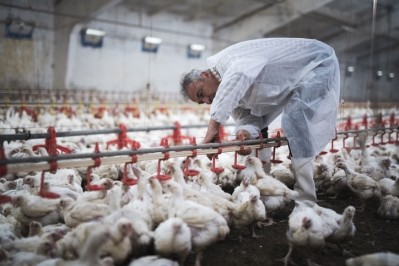To what extent are inflation, disease and transport bottlenecks undermining the growth of the US feed sector?

FeedNavigator spoke to Adriano Marcon, president and group leader for Cargill's Americas animal nutrition and global additives businesses, to hear about ongoing challenges for the US market.
He first noted how the US has been facing inflationary whiplash over the past two years.
“We never had to worry about inflation rates before in the US as typically the currency and purchasing power would adjust."
And while inflation rates have cooled somewhat compared to last year, they remain high. The development can be attributed to many different factors, many of which are a result of the Covid-19 pandemic.
US labor costs have been increasing in 2023 on the back of earlier hikes in 2021-2022, creating difficulties for feed manufacturing facilities. “Labor inflation at the feed plant has increased more than 25% in the past two years,” he noted.
Energy prices have been rising steadily as well.
Manufacturing costs overall, the SG&A expenses, which includes all non-production expenses incurred by a feed company, are hitting US$20 per metric ton. “If you consider that most feed companies do not make US$20 per metric ton in earnings, then inflation becomes a significant disruptor; it just takes their profits away and it's a new phenomenon.”
Then there are growing CAPEX costs: “A new feed plant is much more expensive to build today than it was two years ago,” continued Marcon.
So much so that there has been underinvestment in the sector in the US in the past three years, with that trend particularly pronounced in the pet food industry. “Right now, there is huge demand but not enough pet food production capacity in the US.”
Disease threat
Animal diseases are another increasing concern, and an ongoing disruptor for the North America industry, as elsewhere, added the Cargill lead.
The impact of the avian influenza (AI) outbreak on the US poultry sector was significant; around 15% of the US laying hen population died during the peak period of that outbreak, with the contraction in flock size, in turn, causing significant egg price inflation, said Marcon.
Infrastructure bottlenecks
Along with high inflation and disease challenges, infrastructure bottlenecks have also been creating a headache for the US feed industry.
The Mississippi River is at historically low levels and it directs 47% of agricultural trade in the US.
“Our team is reporting that the low river levels, following a drier than normal crop year, has resulted in higher freight costs – some 40-50% more than a year ago. That creates an additional challenge for us as such a development strains rail and truck transportation. Railroad has not been very reliable of late; we are seeing extended transit times, which can result in outages in the supply of ingredients.”
Marcon was quick to stress that ingredient outages today are far fewer in number than they were two years ago.
Asked whether there are key insights from the pandemic period in managing these kinds of supply chain challenges, he said that Cargill learned that it is critical “to redefine the production grid - we have a network of 60 plants in the US - and we adjust production accordingly. Inevitably, everybody is working with higher inventory levels to take account of any transportation disruptions. Internally, we also focus quite a bit on improving our sales forecast accuracy so that our supply chain managers have a better view of demand and can plan more effectively.”
Process control, margin optimization tools
Countering some of those challenges, the past few years have also seen incremental improvements in feed processing technology, aimed at ensuring greater production efficiency.
The Cargill executive pointed out that, to allow better process control, a lot of effort has gone into automating feed plants in the US.
“Feed equipment manufacturers are integrating digital tools like sensors to help to optimize the pelleting and extrusion processes.”
The agribusiness group itself has been investing a lot of time and money on real-time formulation as well, with it deploying technology such as sensors or probes in the feed mill that are designed to measure variations in nutrient levels - a half a percentage point change in the fat content or in the protein content in soybean meal or in corn, for example, which will then trigger the plant’s control system to adjust the formulation, he said. “Such real time formulation helps us to fully exploit nutrients and reduce waste as well.”
Marcon also outlined how there has been a significant paradigm shift in the sector – a move from a least cost to maximum profitability formulation model in the business. Decision making tools are required to support this industry transition, he said. They can help animal protein companies anticipate how market and company changes could impact their operations, allowing them to see how different strategies could affect their bottom line, helping them make the right adjustments to nutrition and production.
“We are investing in modelling tools that will support customers in scenario planning, to design nutritional approaches for maximum profitability, particularly when there is an environment of low meat prices and high feed costs.”
Labor shortages
Another challenge for the US feed sector of late has been staffing. The industry has seen attrition rates of over 30-40% in the past two years, said Marcon
“North America has been facing labor shortages over the past 18 months. I think it has eased now but if I go back even one year ago it was very difficult to find people to work in feed plants. There was significant talent turnover. We have put greater emphasis now on training people, on flexible shifts, on creating leaders, so that we can retain more employees and reduce attrition. High attrition can create a safety concern. If you are not fully trained up in your role, mistakes can happen.”
In addition, there is change in terms of the competencies required at the feed plant. “The more AI, real-time formulation, automation, sensors, and smart manufacturing tools, the more digital native people are needed to set up and operate those. So, we are seeing a shift in the feed manufacturing plant skill set requirements as well.”
The company, he said, encourages employees to take the initiative when they want to learn a new skill, or if they are curious in terms of learning about a different area of the business.
Back in 2020, Cargill initiated a technical excellence program named Alaatus to engage, develop, and retain top technical leaders while cultivating and empowering a pipeline of talent.
“That program has seen a reduction to almost zero in attrition levels in the technical space. Through it, we teach collaboration, leadership, and project management skills. We connect participants to our global network of knowledge providers, and we encourage them to lead on innovation projects as well.”















